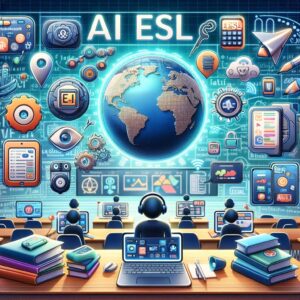Table of Contents
Introduction to AI in ESL Education
The integration of Artificial Intelligence (AI) in ESL (English as a Second Language) education is a hallmark of the digital age. This technology is not just a tool; it’s a transformative force reshaping the landscape of language learning.

The Advent of AI in Language Learning
AI’s entry into ESL education marks a significant shift from traditional learning methods to more adaptive, personalized approaches.
AI’s Impact on ESL Teaching Methods
AI technologies are revolutionizing ESL teaching by providing customized learning experiences and interactive tools that cater to individual learner needs.
Personalization at Its Core
The core strength of AI in ESL lies in its ability to personalize learning, making it more effective and engaging for each student.
Interactive Learning with AI
AI-powered platforms and tools offer interactive and immersive learning experiences, crucial for language acquisition.
Key Advantages in AI Learning

The use of AI in ESL brings several advantages that enhance the overall learning experience.
Tailored Learning Paths
AI algorithms create learning paths that adapt to the learner’s pace, style, and proficiency level, ensuring a more targeted and effective learning process.
Instant Feedback and Corrections
AI tools provide immediate feedback on language use, allowing learners to correct mistakes and learn more efficiently.
Enhanced Engagement and Motivation
The Role of AI in Developing Language Skills
AI plays a crucial role in developing various language skills, making learning more comprehensive.
Improving Pronunciation and Listening
Advanced speech recognition in AI tools aids in pronunciation and listening practice, essential components of language learning.
Building Vocabulary and Grammar
AI-driven exercises and tests help in building a strong foundation in vocabulary and grammar.
Enhancing Reading and Writing Skills
AI tools also assist in developing reading and writing skills, providing suggestions and corrections in real-time.

Overcoming Challenges with AI in ESL
While AI in ESL offers numerous benefits, there are challenges that need to be addressed for its effective implementation. Such soft skills as developing intuition and understanding personal bias are beyond the reach of AI today. Advanced Communication skills such as NLP (Neuro Linguistic Programming) are yet to be demonstrated within the machine learning models. For more insight into NLP…click here!
Bridging the Digital Divide
Ensuring access to AI-powered learning tools for all students, regardless of their background, is crucial.
Maintaining the Human Element
Balancing AI tools with the human aspects of teaching ensures a well-rounded and effective learning experience.
The Future of AI in ESL Education
The future of AI in ESL is promising, with ongoing advancements expected to further enhance its effectiveness and reach.
Emerging Technologies and Trends
We can anticipate more sophisticated AI algorithms and the integration of technologies like virtual reality for an even more immersive learning experience.
Adapting to an AI-Enhanced Learning Environment
Educators and learners alike must adapt to this evolving landscape, embracing AI as a tool for enhanced language education.
Conclusion
AI’s role in enhancing ESL learning experiences is significant and growing. By leveraging this technology, we can provide more personalized, effective, and engaging language learning experiences for ESL students worldwide.
FAQs
Q1: Is AI in ESL learning effective for all age groups?
A1: Yes, AI-powered ESL tools are adaptable and can be tailored to suit learners of all ages, from children to adults.
Q2: Can AI tools help with cultural nuances in language learning?
A2: Advanced AI tools often include cultural context in their learning materials, helping students understand and appreciate the cultural nuances of the language.
Q3: How do AI ESL tools support learners with different learning abilities?
A3: AI tools can be customized to cater to various learning abilities, offering a more inclusive learning environment.
Q4: Are AI-powered ESL tools accessible to learners in remote areas?
A4: As long as there is internet connectivity, AI-powered ESL tools can be accessed from anywhere, making them a valuable resource for learners in remote areas.
Q5: How do AI tools keep up with the evolving nature of language?
A5: AI tools are constantly updated with new data and trends, ensuring that the learning material remains relevant and up-to-date.


